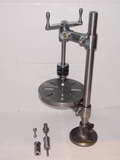Building the GHT UPT
Background and Index
 THESE PAGES UNDER CONSTRUCTION
THESE PAGES UNDER CONSTRUCTION
Created: November 2006
Last Update: May 2007
UPT stands for "Universal Pillar Tool". This tool was designed by George H Thomas (GHT) and first described in a rather dis-joint sequence of articles that appeared in the Model Engineer in the mid-1970's. All of these were later collected into a book titled "Building The Universal Pillar Tool" [1]. After being out of print for some years, the material was combined with that describing GHT's Universal Dividing Head (UDH) and printed as "Workshop Techniques" [2]. This is not a word-for-word reprint of the previous two books; it actually contains useful, additional material!
In the United States, the magazine Home Shop Machinist published a series of articles by Harold Mason describing construction of the same tool (with full acknowledgement to the designer). Mason's 1991 articles simplified some construction aspects, replacing GHT's elegant ball handles with sliding tommy-bar ends like those on a bench vice, but it is essentially the same tool. This series itself was reprinted by Hemingway in the UK as a spiral bound photocopy book with permission of HSM [3]. So we might conclude from all this investment in publishing that the design has significant popularity, but what does it do?
The concept is simple. A sturdy 7/8" diameter, precision ground, mild steel pillar is mounted in a cast iron base. The pillar carries two cast iron arms bored so that 3/4" diameter objects placed in their outer holes will be perfectly parallel. This allows tables and other widgets to be fitted to the lower arm so that their surface will be at right angles to shafts held by bushes in the upper arm. This geometry facilitates tapping, riveting, stamping, drilling, etc. If made correctly, when the two arms are brought into line, their tool holding bores will be concentric. This permits "staking" and light punching operations to be carried out. By engraving the perimeter of the table in degrees and fitting a pointer, the table can act as a divider where accuracy of less than gear-tooth precision will suffice.
Construction of the UPT should be within the skills capabilities of a relative beginner to model engineering, or a complete beginner even, if they are careful. The techniques involved and experience gained will move such a person significantly up the learning ladder and the tool itself will provide a life-time of useful service. There is no commercial equivalent to this device that I know of. If you want one, you make it, or something very similar. But that is part of what makes the hobby of model engineering so enjoyable and satisfying.
The plan for this series of pages is not to write detailed descriptions of all the operations involved in building the tool. This has been covered in better prose by GHT himself in reference [2] which is still in print at the time I write this. But the practicalities of paper-based publishing necessarily restrict the number of photographs that the books can contain. Web-based publishing has no such restriction, so I can present copious construction photos of my example of the tool, in color, adding text to only those operations where I feel that a few words might help a beginner better understand a process, or help prevent them making costly mistakes.
References:
| [1] | Thomas, GH: Building The Pillar Tool, Model and Allied Publications, Watford, England, 1982. |
| [2] | Thomas, GH, Bennett, W (ed): Workshop Techniques, TEE Publishing, Warwickshire, England, 1998. |
| [3] | Mason H: Harold Mason Builds The Pillar Tool, NS&A Hemingway, Lancashire, England, 1991. |

 Model Engine News Home
Model Engine News Home
Back to Model Engineering Index Page
This page designed to look best when using anything but IE! (Firefox is good)
Please submit all questions and comments to
[email protected]
Copyright (c) Ronald A Chernich, 2006. All rights reserved worldwide.


